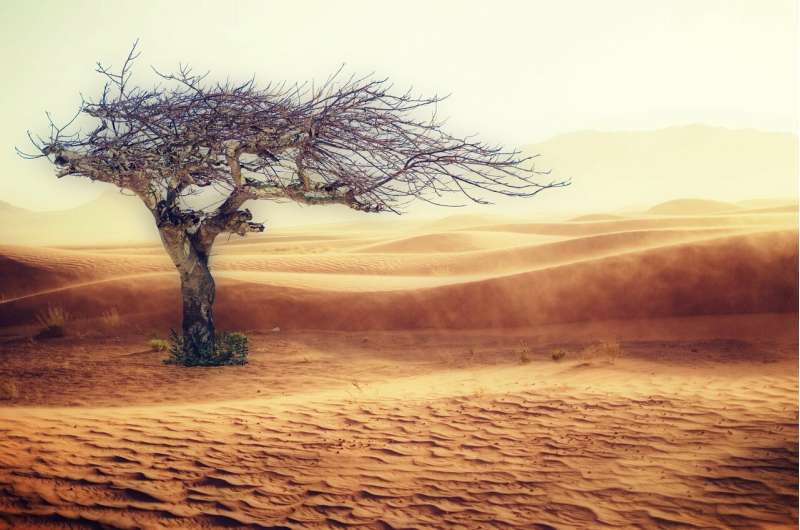This article has been reviewed according to Science X's editorial process and policies. Editors have highlighted the following attributes while ensuring the content's credibility:
fact-checked
trusted source
written by researcher(s)
proofread
Climate change research: If warming approaches 2°C, a trickle of extinctions will become a flood

As delegates discuss the climate crisis in Dubai for COP28, the dazzling variety of life found on Earth hangs in the balance.
Our world has warmed by roughly 1.2°C since the pre-industrial period. Many species are already exposed to increasingly intolerable conditions, driving some populations to die off or contract at the hottest edges of their geographic ranges. Biodiversity is feeling the heat in all ecosystems and regions, from mountain tops to ocean depths.
If all national plans to cut emissions are fulfilled, the world would still be on track for 2.5-2.9°C of global warming by the end of the century. If species are stressed now, imagine how they will fare over the coming decades.
Are there thresholds of warming beyond which the risks to wildlife accelerate? And if so, where and when might we cross them? In short, what does the future hold for Earth's biodiversity?
Answering these questions has been tricky. Computer simulations that attempt to model how biodiversity will behave in a warming world have only compared the current status of species to how it may look at a particular point in the future, such as 2050 or 2100.
In a recent paper, I studied how the area over which species are exposed to potentially dangerous temperatures will expand from one year to the next, from now until the end of the century.
My colleagues and I overlaid the projections of climate models with data on the geographic distributions of more than 35,000 species on land and in the ocean. We found that the area over which each species will be exposed to intolerable temperatures is likely to increase abruptly during the coming decades.
Most populations may initially appear safe. But then, suddenly, a threshold of global warming is crossed beyond which multiple populations across widespread areas face intolerable conditions in rapid succession.
Of the populations within a species projected to be at risk this century, we found that, on average, more than half will switch from being relatively safe to facing dangerous heat in as little as a single decade.
This scenario is already playing out on coral reefs. Just a few decades ago, coral bleaching events driven by extreme sea surface temperatures were rare and localized. Today, these events degrade reefs globally on an almost annual basis.
The sudden increase in risk to species that our models project is in part due to the rapid pace of global warming itself. When combined with natural variability in the climate (El Niño events are one example), warming tends to raise regional temperatures in sudden jumps rather than smooth inclines.
However, we also found that these thermal thresholds are sharpened by the shape of the planet. For instance, across the Amazon basin in South America, temperatures are similarly hot from one place to another. If one population of a species exceeds its thermal limit, it will also be exceeded across many other populations simultaneously.
Life on the line at COP28
What do these results mean for the negotiations at COP28?
Our models project where and when species will be exposed to potentially unsuitable conditions, not if and when they will go extinct. Nevertheless, our results suggest that instead of species gradually sliding towards extinction, climate change could cause populations of species—and the ecosystems they form—to collapse abruptly.
This complicates the already difficult task of conserving and managing Earth's biodiversity. It also highlights the importance of advanced threat assessments and early warning systems to accurately anticipate where and when dangerous warming thresholds will be crossed for different species and regions.
While each species has a threshold beyond which intolerable conditions expand abruptly, the level of global warming at which this threshold is crossed varies from one species to another.
When viewed at the scale of the entire planet, risks to biodiversity increase continuously and relentlessly with the magnitude of global warming. We found that limiting global warming to 1.5°C (the ambition of the 2015 Paris agreement) would leave 15% of species at risk of abruptly losing at least one third of their current geographic range. However, this doubles to 30% of species on our present trajectory of 2.5°C of warming.
As the thermal thresholds of more and more species are crossed, the capacity for ecosystems to adapt—as well as the societies that depend on them—will diminish.
Given that the rapid pace of climate change is likely to exceed the capacity of most species to adapt, our results indicate that there is no safe level of warming for Earth's biodiversity. 2°C is not a safe limit and every fraction of a degree of warming that can be averted matters for limiting the loss and damage of biodiversity.
Burying our heads in the sand will not alter the hard biophysical limits that govern life on Earth—and through which we are rapidly crashing.
Provided by The Conversation
This article is republished from The Conversation under a Creative Commons license. Read the original article.![]()




















